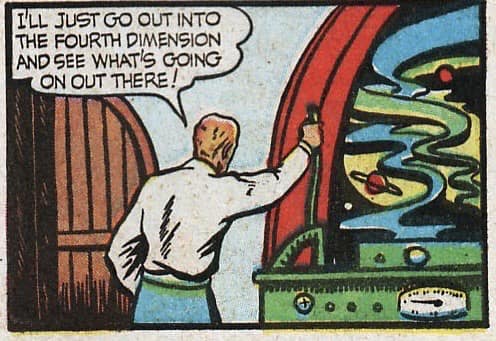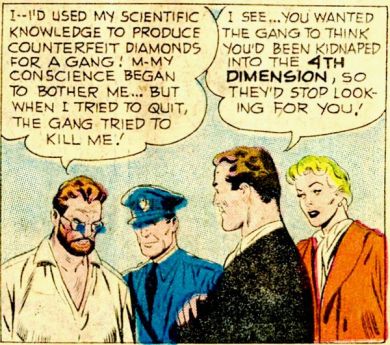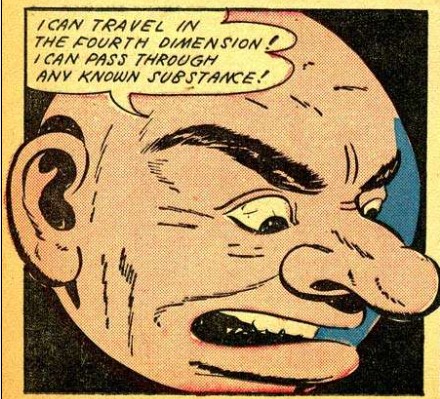


For more of these comics, see Four-Dimensional Comix.
“Mathematical Games: Counting Systems and the Relationship between Numbers and the Real World” by Martin Gardner, Scientific American, “Mathematical Games” column, June 1968 [Excerpt including acknowledgments of R. Dumain et al for solutions to Baker’s Solitaire problem, not included in the anthologies]
“A New Facet of Cubism: ‘The Fourth Dimension’ and ‘Non-Euclidean Geometry’ Reinterpreted” by Linda Dalrymple Henderson (See also Henderson; Kern; below)
Alfred Jarry, Marcel Duchamp, ’Pataphysics, & the Fourth Dimension (excerpts) by Andrew Hugill
Black mystic in hyperspace by R. Dumain
Review: Sydney Padua, The Thrilling Adventures of Lovelace and Babbage by R. Dumain
Arithmophobia summarized by R. Dumain
Nonsense is the Fourth Dimension of Literature by Gelett Burgess
Gustav Spiller Against the Fourth Dimension
Frank Blighton & the Fourth Dimension
“Into the Fourth Dimension” by Frank Blighton
“Into the Fifth Dimension” by Frank Blighton
“The Hop on Hyperspace” by Frank Blighton
Friedrich Engels on Empiricism, Spiritualism, Science, Mysticism, and Philosophical Naivete
La naturesplorado en la mondo de la spiritoj de Friedrich Engels, elgermanigita de Vilhelmo Lutermano (in Esperanto)
Futurism & Four-Dimensional Fascism by Mark Antliff
“Theses Against Occultism” by Theodor W. Adorno: see section VI
Martin Gardner vs General Semantics
“Mathematical Games” by Martin Gardner (Scienterrific American, January 1977, p. 8); parody by Danny Abelson & Ellis Weiner, National Lampoon, January 1977, p. 50.
Board Games & Related Games & Recreations: Web Guide
Homage to Martin Gardner (October 21, 1914 – May 22, 2010) [all links incorporated into the present web page]
Bibliography of Board Games & Related Games & Recreations (As of 30 August 1994) in the collection of Ralph Dumain
Alfred Jarry’s “How to Construct a Time Machine”: A Web Guide
Algorithmic Puzzles: Selected Bibliography
Lewis Carroll’s Logic Games, Mathematical Recreations, Puzzles & Paradoxes
Mathematical Fiction & Related Works: A Guide
Ramon Llull & His Influence: Select Bibliography & Web Guide
Doubt & Skepticism: A Directed Minimal Bibliography & Web Guide
Enrique Gaspar y Rimbau: El anacronópete — The First Time Machine
H. G. Wells’ The Time Machine: Selected Bibliography
Selected Non-fictions: Table of Contents by Jorge Luis Borges; Eliot Weinberger (ed.,tr.), Esther Allen (tr.), Suzanne Jill Levine (tr.)
Jorge Luis Borges: Selected Study Materials on the Web
The Cavalier: Covers & Contents
J. U. Giesy (John Ulrich, 1877-1948) & His Collaborators
Science Fiction & Utopia Research Resources: A Selective Work in Progress
Martin Gardner @ Reason & Society
Testimonial 55: Ralph Dumain (Martin Gardner Testimonials)
Martin Gardner - Wikipedia, the free encyclopedia
List of Martin Gardner Mathematical Games columns - Wikipedia, the free encyclopedia
Martin Gardner bibliography - Wikipedia, the free encyclopedia
Martin Gardner Home Site (Martin Gardner Centennial 1914-2014)
Gardner Index by Carl W. Lee
Martin Gardner's Collections of "Mathematical Games" Columns by Brian Raiter
Martin Gardner: Mathematical Games
The New Martin Gardner Mathematical Library (Cambridge University Press)
A Quarter Century of Recreational Mathematics, by Martin Gardner, originally published in Scientific American, August 1998; reprinted May 29, 2010
“Martin Gardner Mathemagician,” episode of “The Nature of Things,” CBC, 1996 (YouTube, 46:04)
Martin Gardner Communications Award, July 1994, with Gardner interview (YouTube, 14:08)
Game Inventor: Martin Gardner (a tribute from Kadon Enterprises, Inc.)
John Conway Reminiscences about Dr. Matrix and Bourbaki, by Colm Mulcahy, Scientific American blog, April 1, 2015.
See also John Horton Conway @ Board Games & Related Games & Recreations: Web Guide.
The Lives and Games of Martin Gardner - Numericana
The Mathemagician and the Pied Puzzler: A Collection in Tribute to Martin Gardner, edited by Elwyn Berlekamp & Tom Rodgers (Natick, MA: AK Peters, 1999)
|
|
For more of these comics, see Four-Dimensional Comix. |
|
The Unexpected Hanging And Other Mathematical Diversions by Martin Gardner (1991 ed.) *
Martin Gardner | The Church of the Fourth Dimension by Giulio Prisco, October 13, 2012
Fourth dimension - Wikipedia, the free encyclopedia
Four-dimensional space - Wikipedia, the free encyclopedia
Fourth dimension in literature - Wikipedia, the free encyclopedia
Hyperspace - Wikipedia, the free encyclopedia
Johann Karl Friedrich Zöllner - Wikipedia, the free encyclopedia
Spiritualism - Wikipedia, the free encyclopedia
Gustav Spiller - Wikipedia, the free encyclopedia
Edwin Abbott Abbott - Wikipedia, the free encyclopedia
Flatland - Wikipedia, the free encyclopedia
Charles Howard Hinton - Wikipedia, the free encyclopedia
Sphereland - From Wikipedia, the free encyclopedia
Flatterland - From Wikipedia, the free encyclopedia
Rudy Rucker - From Wikipedia, the free encyclopedia
Flatland: A Romance of Many Dimensions, with Illustrations by the Author, A SQUARE [Edwin Abbott Abbott]
Flatland 1965 [film: YouTube]
Flatland: The Film (2007) [YouTube]
The Flatland Store (Flatland: The Movie)
Flatland: The Movie - Wikipedia, the free encyclopedia (2007)
Flatland 2: Sphereland (2012) [IMDB]
Flatland — more YouTube video & audio
C4D | The Church Of The Fourth Dimension
Llull, Bruno, Borges, and the fourth dimension
Charles Hinton and His Cubes by David Auerbach
“Deflating Hyperspace” by David Pacchioli
Natural Science and the Spirit World in Dialectics of Nature by Friedrich Engels
Blindness (1977) by Jorge Luis Borges (mentions Spiller)
Mathematical Fiction: Motif=Higher/Lower Dimensions: Search here
4D Man (1959) (full movie, YouTube, 1:25:00)
The Borderland - Wikipedia, the free encyclopedia (episode of The Outer Limits, aired 16 December 1963,
The Borderland (full episode, YouTube, 51:22)
Musée Patamécanique.
Note the sculpture Time Machine by Dr. Ezekiel Borges Plateau.
The tour concludes with “The Laboratory for the Study of Advanced Fourth Dimensional Mechanics.”
Daren Elsa NiBelly, Vice-Curator, “also teaches Patamechanics at the Center for Advanced Fourth Dimensional Inquiry at Tlon University.”
Abbott, Edwin Abbott. The Annotated Flatland: A Romance of Many Dimensions; introduction and notes by Ian Stewart. Cambridge, MA: Perseus Publishing, 2002. (Re-published: New York: Basic Books, 2008.)
Antliff, Mark. “The Fourth Dimension and Futurism: A Politicized Space,” The Art Bulletin, Vol. 82, No. 4 (Dec., 2000), pp. 720-733. See also: Futurism & Four-Dimensional Fascism.
Arithmophobia: An Anthology of Mathematical Horror, edited by Robert Lewis. Polymath Press, 2024. See:
“Splinters” by Miguel Fliguer & Mike Slater, pp. 22-46.
“Manifold Thoughts” by Patrick Freivald, pp. 47-59.
“A Presence Beyond the Shadows” by David Lee Summers, pp. 245-258.See also: Arithmophobia summarized by R. Dumain.
Bentley, Nancy. “The Fourth Dimension: Kinlessness and African American Narrative,” Critical Inquiry, Vol. 35, No. 2, Winter 2009, pp. 270-292.
See also Du Bois, below.
Blacklock, Mark. The Emergence of the Fourth Dimension: Higher Spatial Thinking in the Fin de Siècle. Oxford, UK: Oxford University Press, 2018.
Borges, Jorge Luis. “A Fragment on Joyce” (1941), in Selected Non-fictions, edited by Eliot Weinberger, translated by Esther Allen, Suzanne Jill Levine & Eliot Weinberger (New York: Viking, 1999), pp. 220-221. Boldface by RD:
My story’s [“Funes the Memorious”] magical compadrito may be called a precursor of the coming race of supermen, a partial Zarathustra of the outskirts of Buenos Aires; indisputably, he is a monster. I have evoked him because a consecutive, straightforward reading of the four hundred thousand words of Ulysses would require similar monsters. (I will not venture to speak of what Finnegans Wake would demand; for me, its readers are no less inconceivable than C. H. Hinton’s fourth dimension or the trinity of Nicaea.)
Borges, Jorge Luis. “Ramón Llull’s Thinking Machine” (1937), in Selected Non-Fictions, edited by Eliot Weinberger; translated by Esther Allen, Suzanne Jill Levine, and Eliot Weinberger (New York: Viking, 1999), pp. 155-159.
We now know that the concepts of goodness, greatness, wisdom, power, and glory are incapable of engendering an appreciable revelation. We (who are basically no less naive than Llull) would load the machine differently, no doubt with the words Entropy, Time, Electrons, Potential Energy, Fourth Dimension, Relativity, Protons, Einstein. Or with Surplus Value, Proletariat, Capitalism, Class Struggle, Dialectical Materialism, Engels. [157]
A Bouquet for the Gardener: Martin Gardner Remembered, by Mark Burstein et al. New York: The Lewis Carroll Society of North America, 2011.
The Complete Time Traveler: A Tourist’s Guide to the Fourth Dimension by Howard J. Blumenthal, Dorothy F. Curley, Brad Williams. Berkeley, CA: Ten Speed Press, 1988.
Dewdney, A. K. The Planiverse: Computer Contact with a Two-Dimensional World. New York: Springer (Copernicus imprint), 2000. (1st ed. 1984)
Du Bois, W. E. B. “A Vacation Unique,” appendix to Dark Voices: W. E. B. Du Bois and American Thought, 1888–1903 by Shamoon Zamir (Chicago; London: The University of Chicago Press, 1995), p. 217-225; and see Zamir’s discussion of the text. See also Bentley, above.
Gardner, Martin. Logic Machines and Diagrams. New York: McGraw-Hill, 1958. (2nd. ed., University of Chicago Press, 1982.)
Gardner, Martin. “The Puzzles in Ulysses,” Semiotica, vol. 57, nos. 3-4 (1985), pp. 317-330. Also in Gardner, The Night is Large: Collected Essays, 1938-1995 (New York: St. Martin’s Press, 1996), pp. 354-367.
Gardner, Martin. Undiluted Hocus-Pocus: the Autobiography of Martin Gardner. Princeton: Princeton University Press, 2013.
* Gardner, Martin. The Unexpected Hanging And Other Mathematical Diversions. 2nd ed. Chicago: University of Chicago Press, 1991. With updated chapters & bibliography, and an afterword. The original edition: New York: Simon & Schuster, 1969.
“The Church Of The Fourth Dimension,” 1969 ed., Chapter 6, pp.65-75; 1991 ed., same + pp. 246-247 (in Afterword) + Bibliography, p. 256.
“An adventure in hyperspace at the Church of the Fourth Dimension,” “Mathematical Games” column, January 1962.
“Flatlands,” 1969 ed., Chapter 12, pp. 136-146; 1991 ed., same + p. 249 (in Afterword) + Bibliography, p. 259.
“Fiction about life in two dimensions,” “Mathematical Games” column, July 1962.
See also: “The pleasures of doing science and technology in the planiverse” [Dewdney], “Mathematical Games” column, July 1980.
And see also other columns & chapters:
“Is it possible to visualize a four-dimensional figure?”, November 1966.
“The orders of infinity, the topological nature of dimension and "supertasks",” March 1971.
“Hypercubes,” in Mathematical Carnival (1975)
“Spheres and Hyperspheres,” in Mathematical Circus (1979)
Note: I read The Unexpected Hanging in 1969, my likely introduction to Flatland and the fourth dimension.
Granville, William Anthony. The Fourth Dimension and the Bible. Boston: Richard G. Badger, 1922.
The Fourth Dimension and the Bible (1922) by Sam Dolbear (The Public Domain Review).
Halpern, Paul. “Spiritual hyperplane,” Aeon, 18 January 2018.
Heinlein, Robert A. Heinlein: “—And He Built a Crooked House—”, 4 illustrations by Charles Schneeman, Astounding Science Fiction, vol. 26, no. 6, February 1941, pp. 68-83. Astounding Stories Magazine & The Pulp Magazine Archive @ archive.org.
Henderson, Linda Dalrymple. The Fourth Dimension and Non-Euclidean Geometry in Modern Art. Revised ed. Cambridge, MA: The MIT Press, 2013. (1st ed.: Princeton: Princeton University Press, 1983.)
Henderson, Linda Dalrymple. “Mysticism as the ‘Tie That Binds’: The Case of Edward Carpenter and Modernism,” Art Journal, Vol. 46, No. 1 (Mysticism and Occultism in Modern Art), pp. 29-37. See also:
“Editor’s Statement: Mysticism and Occultism in Modern Art,” Art Journal, Vol. 46, No. 1, pp. 5-8.
Henderson, Linda Dalrymple. “Mysticism, Romanticism, and the Fourth Dimension,” in The Spiritual in Art: Abstract Painting 1890- 1985 [exhibition catalog. Los Angeles County Museum of Art, November 23, 1986 - March 8, 1987] (New York: Abbeville Press, 1986), pp. 219-37.
Huneker, James. “The Disenchanted Symphony,” in Melomaniacs (New York: Charles Scribner's Sons, 1902), pp. 324-346.
Kern, Stephen. The Culture of Time and Space, 1880–1918, with a new preface. Cambridge, MA: Harvard University Press, 2003. First edition, 1983:
Introduction
1. The Nature of Time
2. The Past
3. The Present
4. The Future
5. Speed
6. The Nature of Space
7. Form
8. Distance
9. Direction
10. Temporality of the July Crisis
11. The Cubist War
Conclusion
NotesIn 1913 Apollinaire commented that Cubists have followed scientists beyond the third dimension and “have been led quite naturally . . . to preoccupy themselves with new possibilities of spatial measurement which, in the language of the modern studies, are designated by the term: the fourth dimension.” 31 There was a popular interest in the fourth dimension in France at that time, which might have inspired the Cubists. 32 [p. 145]
31. Guillaume Apollinaire, Cubist Painters (1913; rpt. New York, 1944), 13. [See pp. 13-17, 61, 98, 129, 135 — RD]
32. E. Jouffret, Traité élémentaire de géometrie à quatre dimensions (Paris, 1903), 153. This connection was made by Linda Dalrymple Henderson in an article on possible influences of physics and geometry on the Cubists: “A New Facet of Cubism: ‘The Fourth Dimension’ and ‘Non-Euclidean Geometry’ Reinterpreted,” The Art Quarterly (Winter 1971): 411-433. She refutes the facile connections between Cubism and science made by Paul M. Laporte and others and shows that although the Cubists could not have known about Einstein’s relativity or Minkowski’s space-time theory, they might have learned about the fourth dimension and non-Euclidean geometry from their friend, the insurance actuary Maurice Princet. Although Picasso denied having discussed the fourth dimension with Princet, she speculates that it is possible that he or the other Cubists picked up a suggestion of it from him indirectly. [p. 338]
Mariën, Marcel. “Non-Scientific Treatise on the Fourth Dimension,” in The Surrealism Reader: an Anthology of Ideas, edited by Dawn Ades, Michael Richardson, Krzysztof Fijalkowski (Chicago: The University of Chicago Press, 2015).
Pawlowski, Gaston de. Voyage au pays de la quatrième dimension. Paris: Bibliothéque-Charpentier, 1912.
Journey to the Land of the Fourth Dimension, translated by Brian M. Stableford. Encino, CA: Black Coat Press, 2009. [Based on the 1923 expanded French edition. See the translator’s introduction via this link.]
Pickover, Clifford A. Jews in Hyperspace. Kindle Edition, 2009.
Pickover, Clifford A. Surfing through Hyperspace: Understanding Higher Universes in Six Easy Lessons. New York: Oxford University Press, 1999.
Robbin, Tony. Shadows of Reality: the Fourth Dimension in Relativity, Cubism, and Modern Thought. New Haven: Yale University Press, 2006.
Throesch, Elizabeth. Before Einstein: The Fourth Dimension in Fin-de-Siècle Literature and Culture. London: Anthem Press, 2017. (Open access by chapter)
Throesch, Elizabeth. “Nonsense is the Fourth Dimension of Literature: Hyperspace Philosophy, the ‘New’ Mathematics, and the Alice Books,” in Alice beyond Wonderland: Essays for the Twenty-First Century, edited by Cristopher Hollingsworth, foreword by Karoline Leach (Iowa City: University of Iowa Press, 2009), pp. 37-52.
See also: Nonsense is the Fourth Dimension of Literature by Gelett Burgess
Van Heijenoort, Jean. “Friedrich Engels and mathematics” (1948), in Selected Essays (Napoli: Bibliopolis; Atlantic Highlands, NJ: Distributed in the U.S.A. by Humanities Press, 1985), pp. 123-151. References for article & whole book, pp. 153-166.
White, Christopher. “Seeing Things: Science, the Fourth Dimension, and Modern Enchantment,” The American Historical Review, Vol. 119, No. 5 (December 2014), pp. 1466-1491.
On the religious crisis & occultist tendency of the time, as experienced by Charles Howard Hinton, on his promotion of the 4th dimension & considerable influence, & on the controversies surrounding the potential of the mathematical imagination.
Home Page |
Site Map |
What's New | Coming
Attractions | Book News
Bibliography |
Mini-Bibliographies
| Study Guides |
Special
Sections
My Writings | Other
Authors' Texts | Philosophical Quotations
Blogs | Images
& Sounds | External Links
CONTACT Ralph Dumain
Uploaded 14 December 2021
Graphics added 26 June & 21 July 2024
Last update 25 October 2025
Previous update
27 July 2025
Site ©1999-2025 Ralph Dumain